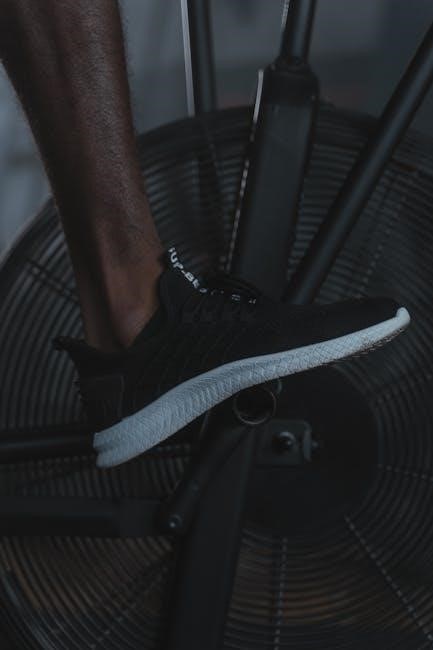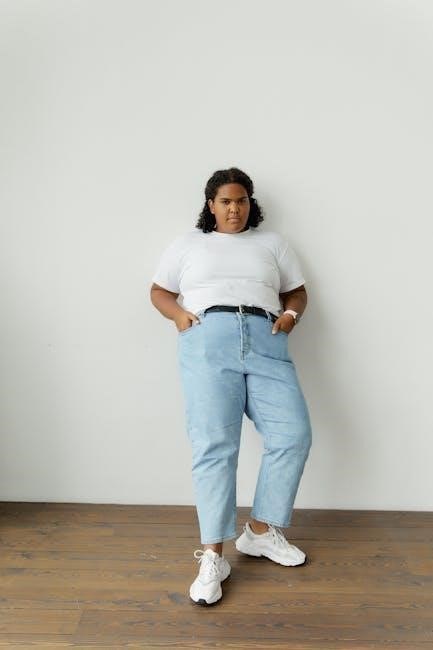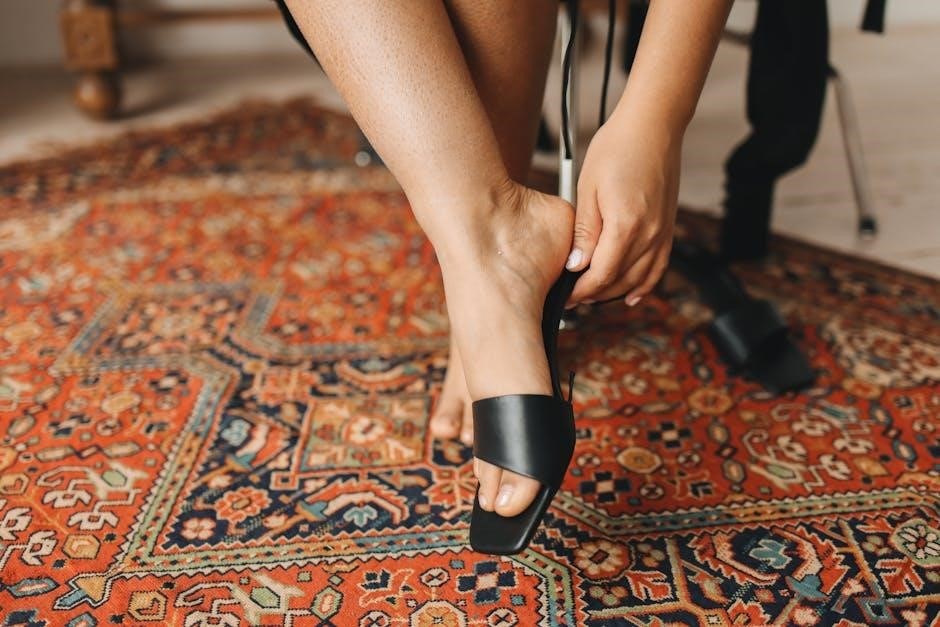Proper shoe fit is essential for comfort and health. Measure foot length and width, consider international sizes, and use our guide to find your fit.
Why Proper Shoe Fit Matters
Proper shoe fit ensures comfort, prevents foot pain, and supports overall foot health. Ill-fitting shoes can lead to blisters, calluses, and long-term foot issues. Measure feet at the end of the day for accuracy, as feet swell naturally. A good fit enhances performance in activities like running or hiking. Poorly fitted shoes can cause discomfort and hinder mobility, making it essential to prioritize accurate sizing for optimal well-being and functionality.
Understanding Shoe Size Measurements
Shoe sizes are based on foot length and width. Use a ruler and wall to measure accurately, as both feet may differ, affecting fit and comfort.
Foot Length and Width: Key Measurements for Shoe Size
Foot length and width are critical for determining shoe size. Measure both feet, as they may differ, using a ruler and wall for accuracy. Proper measurement ensures a comfortable fit.
How to Measure Your Feet Accurately at Home
To measure your feet at home, stand straight and place your foot against a wall. Use a flat ruler to measure the longest point of your foot for length and the widest part for width. Ensure the ruler is parallel to the floor for accuracy. Measure both feet, as they may differ slightly. This simple process helps you determine your shoe size effectively.

Factors Influencing Shoe Size
Foot shape, toe length, and gender differences impact shoe fit. Sizes vary between men and women, and foot size can change over time due to aging.
Differences Between Male and Female Shoe Sizes
Male and female shoe sizes differ due to variations in foot shape and proportions. Men’s shoes are generally wider and longer, while women’s shoes are narrower. A woman’s size 8 often corresponds to a men’s size 6 or 6.5. These differences highlight the importance of using gender-specific size charts to ensure accurate fit and comfort.
How Foot Shape and Toe Length Affect Fit
Foot shape and toe length significantly impact shoe fit. People with longer toes may need more space in the toe box, while those with wider feet require broader shoes. Narrow feet benefit from slimmer styles. Ensuring the shoe accommodates both foot shape and toe length is crucial for comfort and prevents issues like cramped toes or slipping during wear.
International Shoe Size Systems
International shoe size systems vary by region, with US, EU, and UK sizes differing in measurements. Use conversion charts to ensure accurate fit globally.
US, EU, and UK Shoe Size Conversions
Accurate shoe size conversion between US, EU, and UK systems ensures a proper fit. Each region uses distinct measurement standards, so consulting a conversion chart is essential. Slight variations may occur between brands, so always verify specific size guides. Proper conversion helps prevent discomfort and returns, ensuring your shoes fit well regardless of the region or brand you choose.
Use reliable tools to match your size across systems for the best fit.
Understanding Different Sizing Standards
Different regions and brands use varying sizing standards, leading to potential discrepancies. For instance, the US, EU, and UK systems differ in how they measure foot length and width. Some use the Brannock scale, while others rely on the Paris point system. Variations in shoe shapes and materials further complicate sizing. Always refer to brand-specific size charts to ensure accuracy and comfort. This helps in making informed purchasing decisions.
Consistency in measurement methods is key to finding the right fit.

How to Determine Your Shoe Size
Measure your feet using a ruler, compare with size charts, and ensure a comfortable fit. This easy guide helps determine your perfect shoe size.
Step-by-Step Guide to Measuring Foot Length and Width
To measure your foot accurately, stand on a flat surface with a wall behind you. Place a ruler at the wall base, aligning it with your longest toe and the back of your heel. Record the length in inches or centimeters. For width, measure the widest part of your foot, typically between the big toe and little toe joints. Use these measurements to compare with shoe size charts for the best fit. Ensure to measure both feet, as they may differ slightly. Do this in the evening, as feet tend to swell throughout the day. For precision, consider using a Brannock device or a printable shoe size guide available online. This method helps in determining your correct shoe size and width, ensuring comfort and proper fit. Remember, accurate measurements are crucial for selecting shoes that accommodate both length and width effectively. By following these steps, you can avoid common sizing mistakes and find shoes that feel great all day long. This guide provides a reliable way to measure at home, making online shopping easier and more accurate. Always double-check your measurements to ensure consistency and the best possible fit for your footwear needs; Avoid relying solely on previous sizes, as feet can change over time due to factors like age or weight changes. Taking the time to measure properly will lead to a more enjoyable and comfortable shoe-wearing experience. For those who find it challenging, asking a friend or family member for help can make the process smoother and more accurate. Additionally, many shoe brands offer size guides specific to their products, so comparing your measurements with these charts can further enhance fit accuracy. Overall, measuring your foot length and width is a simple yet essential step in finding the perfect pair of shoes. By doing so, you can prevent issues like tight or loose shoes, which can cause discomfort and potential health problems. This step-by-step approach ensures that your shoes fit well, providing the necessary support and comfort for daily activities or specific sports and events. Whether you’re shopping online or in-store, having accurate measurements gives you confidence in your size selection, making the shopping experience more efficient and satisfying. So, take the time to measure your feet correctly and enjoy the benefits of well-fitting shoes for years to come.
Using Size Charts for Accurate Fit
Refer to shoe size charts to match your measured foot length and width with the corresponding size. Consider differences in sizing standards across brands and regions. Use international conversion charts for consistency. Pay attention to width options like narrow, medium, or wide. Double-check the specific brand’s size guide, as sizes can vary between styles. This ensures a more precise fit, reducing the risk of discomfort or returns. Always verify measurements for accuracy to find your ideal shoe size and width combination, ensuring optimal comfort and support tailored to your foot shape and needs. By aligning your measurements with the chart, you can confidently select shoes that fit well, whether shopping online or in-store. This step is crucial for achieving a comfortable and proper fit, especially for those with specific foot shapes or preferences. Using size charts effectively helps in making informed decisions, ensuring your shoes meet your comfort and performance expectations. This approach minimizes sizing errors and enhances your overall shoe-buying experience, providing peace of mind and satisfaction with your purchase. Accurate fit is key to enjoying your shoes, and size charts are a reliable tool to achieve this goal. Always prioritize using up-to-date and brand-specific charts for the best results. By doing so, you can enjoy shoes that feel great and perform well for their intended purpose, whether for casual wear, sports, or formal occasions. This method ensures that every pair you choose is a perfect match for your feet, delivering comfort and confidence with every step.
Best Practices for Trying On Shoes
Try shoes in the afternoon, as feet swell during the day. Wear the same socks you’ll use with the shoes. Measure both feet and fit to the larger foot. Walk around to ensure comfort and support, avoiding tight or loose areas. This ensures a proper fit and prevents discomfort or blisters over time.
When to Measure: Morning vs. Evening
For accurate shoe sizing, measure your feet in the evening, as feet naturally swell throughout the day. Morning measurements may result in smaller sizes, while evening measurements account for swelling. This ensures shoes fit comfortably all day. Avoid measuring after prolonged standing or exercise, as this can cause temporary swelling. Consistency in timing helps maintain reliable measurements for the best fit.
How to Ensure a Comfortable Fit
To ensure a comfortable fit, measure your feet accurately and try shoes on in the evening, as feet swell throughout the day. Choose shoes that fit snugly but not too tight, allowing wiggle room for toes. Consider the shape and width of your feet, as well as specific activities, like running or hiking, which may require specialized fits. Orthopedic or wide-fit options can also enhance comfort and support.

Common Mistakes to Avoid
Relying solely on shoe size numbers and ignoring foot width and shape are common errors. Always measure feet accurately and consider fit over size labels.
Relying Solely on Shoe Size Numbers
Relying solely on shoe size numbers can lead to poor fit, as sizes vary between brands and styles. Foot shape, width, and length all impact comfort and proper fit. Always measure both feet and consider width for accuracy. Use size charts and try shoes on to ensure the best fit. Ignoring these steps may result in discomfort or ill-fitting shoes, even if the size number seems correct.
Ignoring Foot Width and Shape
Ignoring foot width and shape is a common mistake that leads to discomfort and poor fit. Foot shape varies, and width plays a crucial role in comfort. Narrow or wide feet may require specific sizes or styles. Relying only on length can result in tight or loose shoes, causing blisters or poor support. Always measure width and consider foot shape for optimal fit and comfort.
Specialized Shoe Fits
Specialized shoe fits cater to specific needs, offering orthopedic support, wide-fit designs, and activity-specific styles for optimal comfort and performance in various settings.
Orthopedic and Wide-Fit Options
Orthopedic shoes offer essential support for foot conditions, featuring cushioned insoles and sturdy arch support. Wide-fit options accommodate larger or swollen feet, ensuring comfort without pressure. Adjustable straps and breathable materials enhance fit customization, making these styles ideal for individuals requiring extra care and space.
Shoes for Specific Activities: Running, Hiking, etc.
Running shoes prioritize cushioning and support for high-impact activities, while hiking boots emphasize durability and traction. Proper fit ensures optimal performance and comfort. Moisture-wicking materials and breathable designs are key for extended use. Always choose footwear tailored to your activity for enhanced support and to prevent injuries, ensuring a secure and comfortable fit during any adventure or workout.

Maintaining Proper Fit Over Time
Foot size can change with age, so regular measurements are essential. Proper shoe care, like avoiding extreme heat, helps preserve fit and extends shoe lifespan.
How Foot Size Changes with Age
Foot size naturally changes with age due to factors like weight fluctuations, health conditions, and wear and tear. As people grow older, feet may lengthen or widen, requiring larger sizes. Regularly measuring feet ensures proper fit. Measure at the end of the day when feet are largest. Ignoring these changes can lead to discomfort or shoe damage. Proactive care helps maintain comfort and extends shoe lifespan.
Caring for Shoes to Preserve Fit
Proper shoe care extends their lifespan and maintains fit. Clean shoes regularly to prevent damage, and store them in cool, dry places. Avoid extreme heat, as it can warp materials. Use shoe trees to retain shape and consider waterproofing for leather. Condition materials like suede or leather to prevent cracking. Regular maintenance ensures shoes remain comfortable and supportive over time.
The Future of Shoe Sizing
Technology like 3D scanning and AI is revolutionizing shoe sizing, offering precise fits and custom designs. These innovations ensure accuracy and comfort for all foot shapes and needs.
Technology and Innovation in Shoe Fit
Advances in shoe sizing include 3D scanning and AI-driven fit recommendations. These tools provide precise measurements and personalized shoe suggestions. Mobile apps and augmented reality (AR) enable virtual try-ons, while smart insoles analyze gait and pressure points. Such innovations aim to enhance comfort and accuracy, making shoe shopping more efficient and tailored to individual needs. The future of shoe fit is increasingly tech-driven and customizable for optimal performance and comfort.
Custom and 3D-Printed Shoes
Custom and 3D-printed shoes offer tailored fits using precise foot measurements. This technology allows for unique designs, accommodating specific foot shapes and orthopedic needs. Advanced 3D scanning captures detailed foot anatomy, ensuring a perfect match. These innovations enable personalized comfort and support, making custom shoes ideal for individuals with unique requirements or preferences. The rise of 3D printing is revolutionizing footwear, providing bespoke solutions for enhanced fit and performance.
Proper shoe fit is key to comfort and health. Use our guide to measure accurately, consider size charts, and explore options like custom shoes for the best fit.
Final Tips for Finding Your Perfect Shoe Size
Always try shoes on in the afternoon, as feet swell during the day. Use size charts and consider width for comfort. Prioritize activity-specific shoes for optimal performance. Don’t rely solely on size numbers, as fittings vary by brand. Explore custom options for unique foot shapes. Regularly check your size, as feet change over time. A perfect fit ensures comfort and prevents foot issues.